June 19, 2025 | 04:05 GMT +7
June 19, 2025 | 04:05 GMT +7
Hotline: 0913.378.918
June 19, 2025 | 04:05 GMT +7
Hotline: 0913.378.918
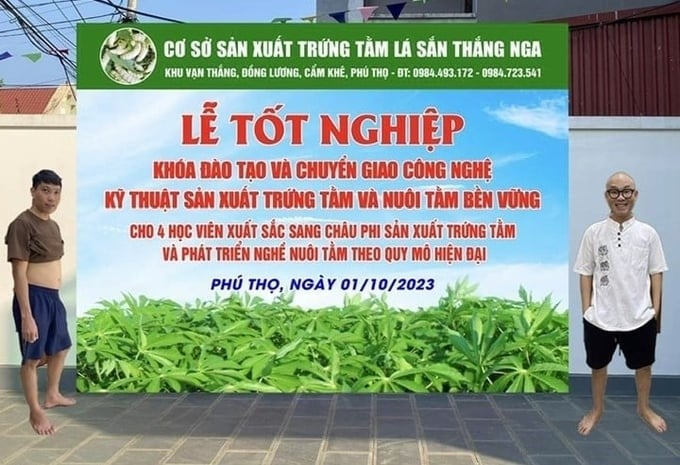
The happy graduation ceremony of students going to Africa to raise silkworms. Photo: Provided by the character.
Mr. Nguyen Quang Thang in Van Thang area, Dong Luong commune, Cam Khe district, Phu Tho province, said that "Not only do Vietnamese people have the habit of using silkworms as food, but even some countries in the world also have this trend. Recently, a Vietnamese boss who had been doing business in Zambia, Africa, for several years wanted to develop an agricultural model there, so he brought four students here to ask me for training in cassava silkworm seed production and cassava silkworm farming.
Those four people were taught by me for one month, both learning theory and practicing in an on-the-job training method. They have graduated and come back to Zambia. They will bring cassava varieties from Vietnam to plant in the next crop because indigenous African cassava has a low yield of leaves and roots.
The Vietnamese now start coming to explore Africa and do agriculture such as digging fish ponds and growing rice, corn, beans, and cassava. Growing cassava aims to use the roots for food and the leaves for raising silkworms. Silkworms are served both as food for freshwater fish and as food for humans. The advantage is that the people of Zambia have a habit of eating some types of insects, but they do not know how to eat cassava silkworms because they have never been approached."
Teacher Thang, owner of the Thang Nga cassava silkworm egg production facility, awarded the "red diploma" (a technical folder with a red cover) to the students of the graduation ceremonies of courses to train and transfer technology and techniques of silkworm egg production and sustainable silkworm farming. That teacher has received many certificates of merit, including those of the Prime Minister and the Vietnam Farmers' Association, to recognize him as a good producing and trading household at the central level.
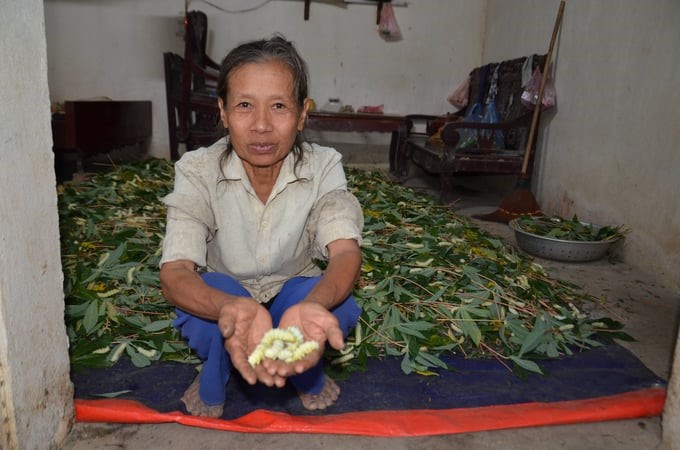
Cassava silkworm farming in Dong Luong. Photo: Duong Dinh Tuong.
The professional cassava silkworm seed production profession has stuck with Mr. Thang for nearly 30 years. A century ago, villagers, as well as his parents, knew how to raise cassava silkworms for food, but they only kept the seeds based on their experience of choosing healthy and beautiful heads, without the habit of buying seeds.
At that time, one of Mr. Thang’s neighbors, who used to work at the Mai Linh Silkworm Seed Company specializing in mulberry silkworms in the former Ha Tay province, rented an abandoned house to experiment with producing cassava silkworm seeds because of cassava hills and traditional cassava silkworm farming here. That man bred cassava silkworms and sold them on credit to the people. When people harvested, each package of silkworm eggs would give him back three ounces of silk. After two years, he passed the profession on to his son.
However, the son did not sell silkworm eggs on credit and then exchange silk at the end of the crop, but rode his bicycle to communes and districts to sell for real money. In 1995, when Mr. Thang was only 16–17 years old, he found it interesting and asked to be taught the profession. Then he continued to cycle to farther communes and districts, such as Thanh Son and Yen Lap in Phu Tho province, to sell silkworm eggs.
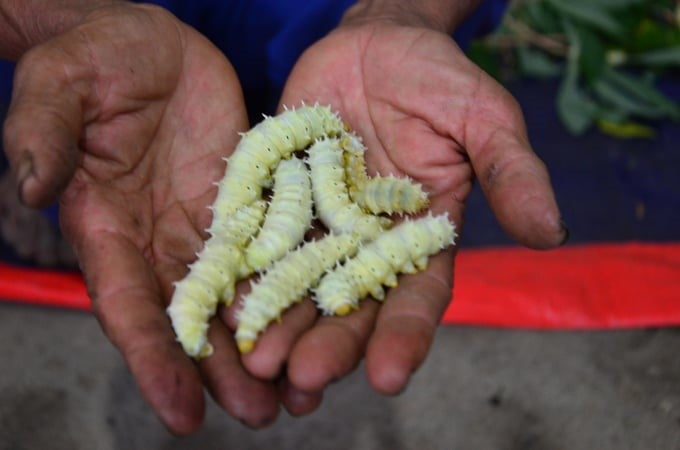
Close-up of the cassava silkworm. Photo: Duong Dinh Tuong.
In the past, when raising cassava silkworms, people did not know what diseases they had but only said it was due to heavy rain or toxic dew. Later, when he experienced failure many times, Mr. Thang changed the breeding method by eliminating silkworms that had diseases such as viral disease and pebrine disease from the beginning, so the silkworms developed into moths better, laid more eggs, and had a higher rate of finished products.
People buying eggs from him saved the effort of self-propagation, while the silkworms were healthy and beautiful, with many consecutive litters. As for those with self-propagation, the silkworms did not develop into moths much, and there was no production efficiency, so they were curious to try buying eggs to raise and compare. The whole village and commune gradually formed the habit of only buying seeds.
After selling the seeds, Mr. Thang also enthusiastically takes care of customers by instructing them on how to raise silkworms so that silkworms do not get "unlucky with water from the Thao River" in the rainy season or do not get toxic dew and die like flies in the winter. Thanks to that, he produced 7kg of eggs in the first year and 20 kg in the second year. His production gradually increased. The market ranges from retail to wholesale, from a few communes in the district to a few districts in the province, and then across the North, Central, and South. In 2005 when finding an output for the scrap cocoons after exploiting cassava silkworms for food, silkworm farming truly became a profession for hundreds of households in Dong Luong commune.
However, he was unsatisfied with the indigenous cassava silkworm of his hometown. On one occasion, he heard someone tell him that people in Son La province have a silkworm variety crossed between a worm and a cassava silkworm because their house was near the forest, and butterflies in the forest flew to mate haphazardly. Mr. Thang rode his motorcycle up there three times to find out.
If the cassava silkworm variety from his hometown is small, dark yellow, and weighs 280–300 heads/kg when mature, the hybrid silkworm variety is much larger, with only 180–200 heads/kg and thick silk and beautiful cocoons. Moreover, they eat very well, even the cassava leaf petiole, veins, and bones.
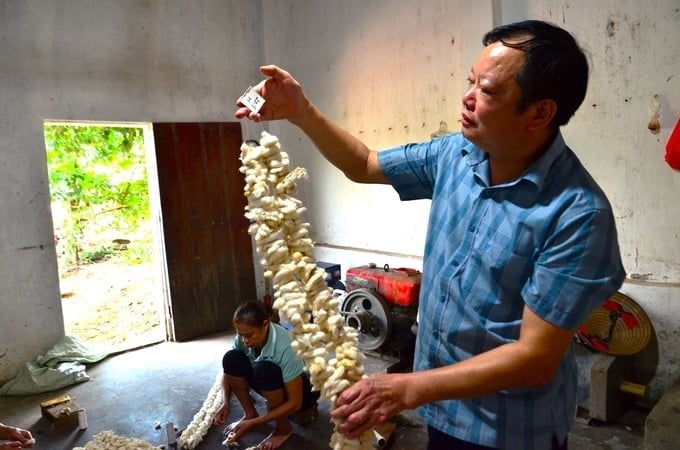
Mr. Thang is next to a string of seed cocoons. Photo: Duong Dinh Tuong.
He immediately bought 20kg of hybrid silkworms and brought them back to Dong Luong to try raising them. When hearing the news, a compact crowd came to see it. Seeing that the hybrid silkworms were not only huge but also green in color, not dark yellow like the silkworms they were raising, they did not believe those worms to be silkworms. He smiled and replied, "This is a hybrid cassava silkworm variety of people in Son La province." However, only after 1-2 farming crops, thanks to the outstanding productivity of 30–40%, people now almost only raise hybrid cassava silkworms and no longer raise pure cassava silkworms.
Currently, his facility produces an average of 600–650 kg of silkworm eggs/year, earning a profit of VND 400–500 million/year and creating jobs for 15 workers with a salary of VND 6 million/month. In Dong Luong cassava silkworm village, two households have had to quit their jobs since last year because they sell products not through the brand but through their personal reputation. However, Mr. Thang and two of his younger brothers still persistently stuck to cassava silkworms and earned good profits.

Mr. Thang (white shirt) with students of a recently graduated course. Photo: Provided by the character.
Being asked why the dish made from cassava silkworms has not spread to big cities but is only available in the midlands and mountains, Mr. Truong Van Chi, the second largest cassava silkworm seed producer in the village, replied, "Because the city people are scared when they look at the silkworm, but they do not even know that it is very nutritious and clean, and everyone can eat it except for allergic people. Silkworms can prepare many delicious dishes. After 3-5 days, when you cut out the cocoons and see silkworms peeling off their shells, turning into young yellowish-white pupae that are filled with milk, in just about 10–15 minutes, you place them immediately in a water basin. After that, it is the most delicious dish when boiled with lemon leaves and dipped in chili salt. That type of pupae sells for VND 250,000/kg. Another dish is that silkworms, after being cooked for about 2–3 hours and waiting to make all the water in their stomachs, are boiled with lemon leaves and roasted with pork belly, which is also very delicious.
Some people like silkworms when they are ready to ripen, with a clear body but not yet "swollen" because they haven't urinated yet. Even though all the feces in its body are gone, there is still an intestine that contains nutrients, like a pig tripe. When boiled, it is very sweet and can be eaten up to half a kilo. There are communes where the wedding feast will not be luxurious if it lacks the green silkworm dish.”
People transport cassava silkworms for food in mesh bags. Each bag holds about 25kg. When tied, silkworms spread out on their own, so they can be overlapped in 2-3 layers. In hot weather, silkworms die very easily, but if they are put in the refrigerator, they will go into hibernation. When left out after a week, they still crawl back as normal.
Translated by Huyen Vu Thu
/2025/06/17/3942-2-143243_548.jpg)
(VAN) Recently, in Sweden, the Secretary of the Binh Dinh Provincial Party Committee presented the Investment Registration Certificate for the 'Polyester Fabric Recycling Complex' project to SYRE Impact-AB Company.
/2025/06/12/3721-2-202745_83.jpg)
(VAN) TH made an impression at Seoul Food 2025 with its line of natural beverages, paving the way for Vietnamese food products to enter the South Korean market.
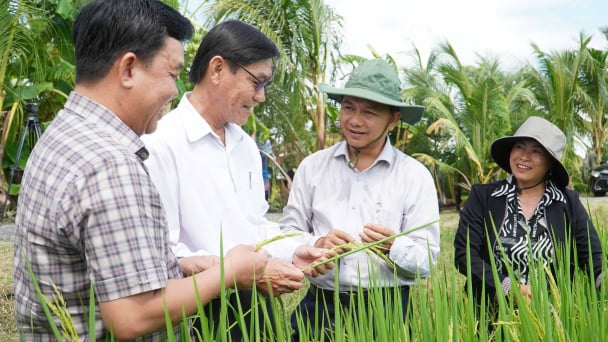
(VAN) Soc Trang's success in rice exports stems from a strategy of developing fragrant and specialty rice cultivation areas and standardizing production toward low-emission practices.
/2025/06/11/1311-5-120811_839.jpg)
(VAN) The pig farming industry is facing the challenge of comprehensive restructuring to meet requirements for quality, safety, traceability, and market expansion both domestically and for export.

(VAN) Vietnam considers participating in ALGROALBA in order to expand agricultural production, coordinate the assessment and effective exploitation potential land.
/2025/06/05/5314-1-184727_407.jpg)
(VAN) From seemingly worthless fish scales and skin, enzymes and lactic ferments can transform by-products into peptides, opening a sustainable, effective business direction and elevating Vietnamese seafood.

(VAN) TTC AgriS and IFC signed a strategic partnership to develop a sustainable agricultural value chain, aiming to achieve the Net Zero target by 2035.